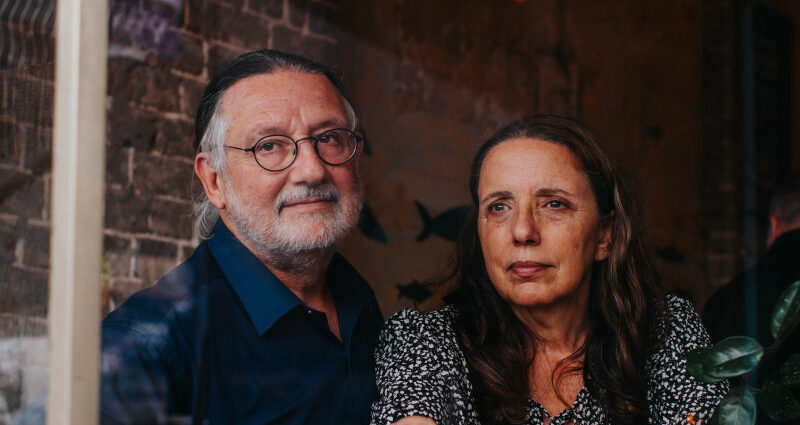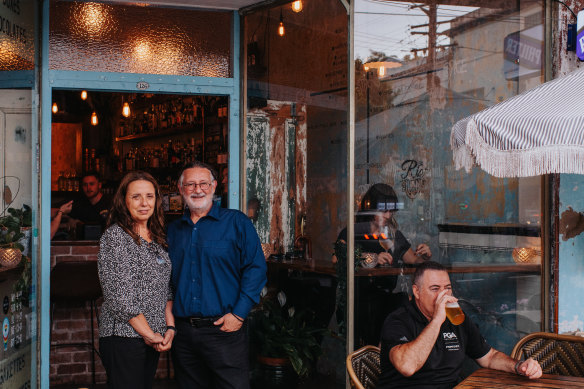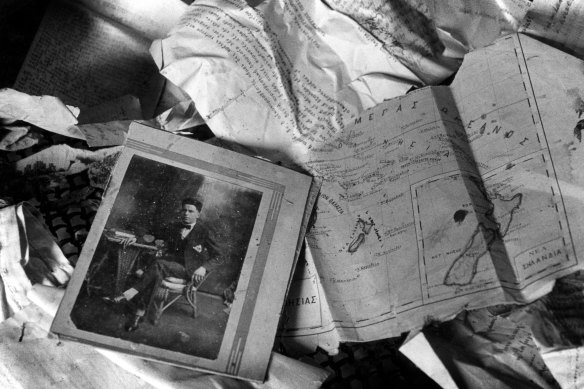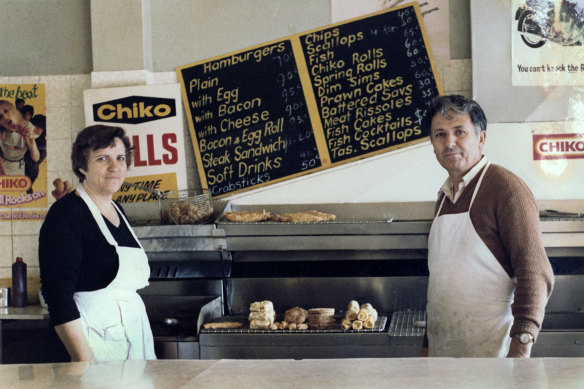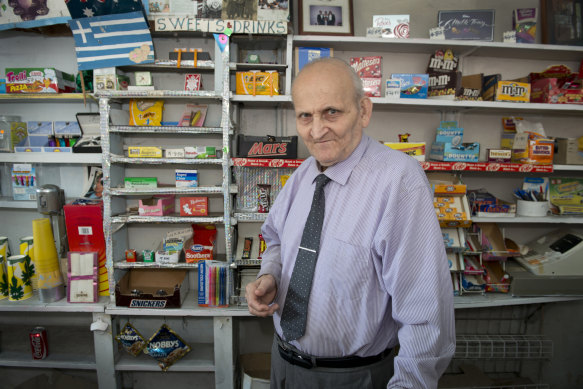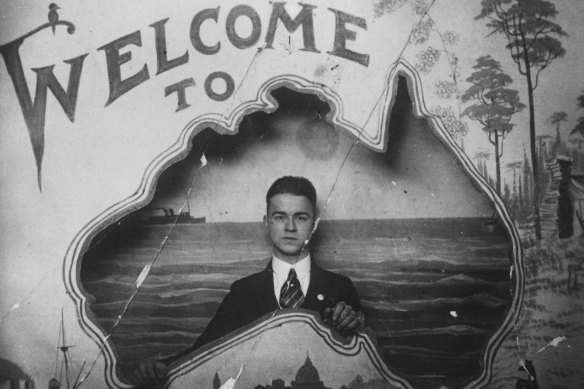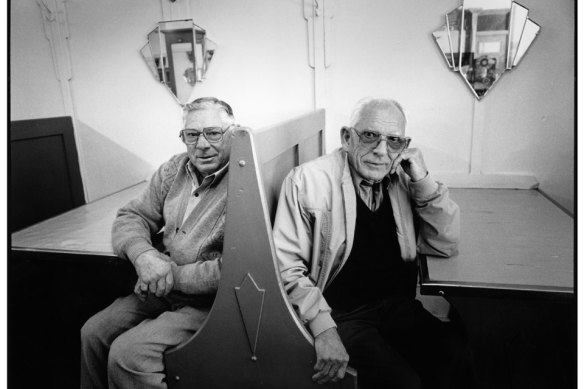By Julie Power
Save articles for later
Add articles to your saved list and come back to them any time.
When Leonard Janiszewski began a masters in history he was interested in studying Australia’s diverse population – its First Nations people and migrants.
After meeting Effy Alexakis, a photographer and his partner in life and
work since the early 1980s, Janiszewski, a social historian and curator with Macquarie University, told a senior academic he wanted to record the history of the Greek contribution to Australia.
“Don’t look at that,” he was told. “If you really want to become a professional historian, go off to Great Britain.”
Yeah, nah! The couple went to Greece where they found Australian history in the ruins. Homes and entire villages had been abandoned in the chain of migration.
“People had locked up their houses, and left,” said Alexakis. Some thought they were going for five years, but never came back.
Leonard Janiszewski and Effy Alexakis are Australia’s experts on Greek cafes, and the contribution of Greek migrants to Australia. Most Greek cafes/milk bars in Sydney are closed now, some remain in country towns.Here Leonard and Effy are pictured in a former greek cafe that retained the shop front and has been turned into a modern bar.Credit: James Brickwood
“We went into the houses, and we found photos and letters from Dubbo and other places – with letterheads – telling relatives to come; ‘There’s work’,” she said. “Some whole villages had been deserted because they had all migrated. So there were, like, social history museums rotting away.”
Among the discoveries was a trunk in an abandoned home in Kythera, one of three islands where most Greek Australians came from.
It contained a scrap of a map with Australia and New Zealand outlined, an Australian magazine Walkabout dated December 1, 1937, and a formal portrait of a young man by Australian photographer J. Check in 1926.
Over the years they took photos, recorded oral histories, interviewed Greek Australians in Australia and the families they left behind in Greece, and wrote books, academic publications and exhibited their work.
Alexakis said many Greeks had been stuck in limbo, going back and forward between Australia, not quite fitting in anywhere.
Together, the couple have documented a history of Greek Australians that is far older and more diverse than the occupational stereotype of the Greek cafe owner.
The first Greeks to arrive in Australia were seven sailors, convicted of piracy by the British and given a life sentence. They arrived on the Norfolk in 1829. Five returned to Greek after being pardoned. Two remained. They were Georgios Vasilakis, Gikas Voulgaris, Georgios Laritsos, Antonis Manolis, Damianos Ninis, Nikolaos Papandreas and Konstantinos Strompolis.
Writing in the Greek City Times, Alexakis and Janiszweski said the next big wave was those who came for the gold rush and stayed for other opportunities.
So many migrated that an area of Hill End was known as Greektown. Its residents were cared for by Dr Pericles, the second Greek educated doctor to migrate.
Others brought Greek sultanas to cultivate in Mildura. In Queensland, Greeks migrated to cut cane, and ended up controlling the industry and owning sugar cane fields. Others cultivated rice, cotton and ran cattle and sheep.
As Greeks sought a new life in Australia they abandoned personal documents, homes and whole villages.Credit: Effy Alexakis
Greek doctors and dentists and other professionals followed too.
Many who came for gold ended up in food service, and anglicised their names. For example, in Sydney, John Capatchos (Kapazzo/Kapazzos), became an oyster saloon keeper. Others became fishmongers, fruiterers, publicans and cafe proprietors.
This year, Alexakis and Janiszewski published a retrospective of Alexakis’ photos: Forty Photographs: A Year at a Time.
The first photo, taken in 1982, is of her parents Maria and Spiros Alexakis, who ran a fish and chip shop, Nita’s Seafoods, in Padstow. Alexakis often photographed her parents at work – her mother frying, her father at the fish markets.
“But I was not to know that this would be the last photo taken of them together in their shop,” she wrote.
The unexpected death of her middle-aged father – soon after the photo was taken – was the catalyst for the photographer’s search to understand her father’s move to Australia and the sense of “Greekness” that he retained in his new country.
The last photo of Effy Alexakis’ parents Maria and Spiros Alexakis together in their shop in Padstow.Credit: Effy Alexakis
His death turned her interest in elevating awareness of Greeks in Australia beyond a footnote in history into an obsession, Janiszewski says.
Like young lovers do, they made a pact back then. “Us against the myopia of misrepresentation,” he wrote. “Four decades later, the alliance has remained steadfast.”
The couple wanted to combat the pervasive stereotype of Greek Australians as cafe-owning-dancing-wearers-of-colourful- traditional costumes. (Don’t mention plate smashing.)
They deliberately chose to delay publishing what Alexakis acknowledges is “their best-known” book, Greek Cafes and Milk Bars of Australia, until after they’d completed two books detailing the history and diversity of Greeks in Australia.
This month they launched their fifth book, The Heart of Giving. It’s a collection of photos by Alexakis that pays homage to the Greek Orthodox priest Father Nektarios Zorbalas and the soup kitchen he operated thanks to volunteers for the homeless.
It’s a more personal book than their others. Started in lockdown, when Alexakis visited the kitchen once a week, it’s a return to the idea of food, generosity and hospitality that they documented in their book on Greek cafes.
For this interview, Alexakis and Janiszewski suggested we meet at the only cafe in Sydney with signs of its former Hellenic life.
George Poulos, the late owner of the Rio, a Greek cafe in Summer Hill. Credit: Effy Alexakis
The Rio in Summer Hill was operated by George Poulos, a former cane cutter who died in 2015 aged 92. Now a wine bar, it has some original features, but not much else from its heyday when it had a jukebox and booths.
The couple have been together for so long that they finish each other’s sentences, sometimes making it difficult to hear who said, “We finish each other’s sentences. ”
Richard Neville, the Mitchell Librarian at the State Library of NSW, is impressed by the sheer scale and academic rigour behind their work.
By the early 1990s, their research had resulted in 30,000 contemporary photos, 10,000 historical photos, 900 oral histories gathered in trips across Australia where they racked up 20,000 kilometres in some years.
Their research told the story of Greek Australia from the bottom up, showing the messy complexity of shifting lives from one country to another, Neville wrote in the forward to Forty Photographs.
Their research discovered photographic evidence that it was the Greeks who brought American culture to Australian suburbs and country towns.
The cafes were a Trojan horse for the Americanisation of Australian culture, said Janiszewski.
Bill Florence (Vasilios Florias) being welcomed to Australia, Melbourne, 1922.Credit: Courtesy of S. Raftopoulos and J. Florence and Greek-Australians: In Their Own Image. National Project Archives
Cafe owners bought jukeboxes with American music that had yet to hit the airwaves.
They didn’t offer moussaka or lamb, but American food – hamburgers, ice cream sundaes, milk shakes in chrome cups, and hard candy.
They contributed to a major change in Australian eating habits prior to the explosion of fast-food franchises, said Janiszewski.
The names of the cafes conjured up glamour and American life – The New York Cafe, the Capitol, the Niagara in Gundagai, the Paragon in the Blue Mountains, American Bar and the Blue Bird Cafe.
Many owners travelled to the United States for inspiration on food and architectural styles, bringing back plans for lots of bling and mirrors.
The Castrission family bought the Niagara in Gundagai in 1938, and travelled to the United States for ideas.
The style was “American streamline, moderne, art deco”, Janiszewski was told. It was “all coloured glass and shiny metal surfaces, large reflective mirrors, polished marble, wooden booths, neon lights, air-conditioning, wave windows in the front”.
It was also the Greeks who brought to country towns and suburbs the idea of creating a place that stayed open late, where everyone was welcome – an alternative to the country pubs that were mostly restricted to men.
Janiszewski said despite that the Greeks faced prejudice: they weren’t seen as white.
Greek cafe owners never wanted their own children to run the cafes, seeing them as a way to fund the next generation of professionals.
Actor Lex Marinos wrote in the preface to the cafe book that his grandfather’s cafe was the epicentre of his young life. “Sometimes I would be ashamed to be serving kids from school who made fun of my family’s accents and customs,” he wrote.
Peter (Beneto) and Jack (Ioannis) Veneris, at the Blue Bird Cafe in Lockhart, NSW. The Veneris family owned the cafe for 70 years.Credit: Effy Alexakis
But the cafe was a metaphor for life, the acts of eating and drinking, the communal bond and warmth of family and friends, shopkeeper and customer, the entrances and the exits, he wrote.
Alexakis and Janiszewski are now working on their second book about Greek cafes. The first included 150 stories of families, but they still got complaints: “You haven’t got my family.”
As they travelled around Australia, it seemed every Greek family knew someone in the family who had a cafe, said Alexakis.
And whether you are of Greek descent or not, nearly everyone has a memory of these institutions, which have all but disappeared. The cafes – and oyster bars and suburban fish and chip shops – elicit massive scoops of “I remember when”, particularly among older Australians.
Alexakis said she was most proud that so much of the history they documented came from people’s personal albums. “Unique, and rare, those images belong to people and not to the institutions.”
Today they are still fighting prejudice and stereotypes, and trying to increase the representation of Greek Australians in libraries and history.
Even now, fourth, fifth and sixth generation Greek Australians are called migrants.
Why? “Because if you have a long name, you get called a migrant,” says Alexakis.
The State Library’s Neville says without the couple’s work, “we would be still stuck it the age-old fictions that all Greeks owned milk bars.”
“What their work reveals about the migrant experience, and how migration transitions into permanently putting down roots in a new country is a real counterpoint to the stereotypical mainstream views of migration.”
To read more: https://cafesandmilkbars.com.au/
Start the day with a summary of the day’s most important and interesting stories, analysis and insights. Sign up for our Morning Edition newsletter.
Most Viewed in National
Source: Read Full Article
-
Mother of one of Dahmer's victims slams Evan Peters' Golden Globes win
-
Paul Pelosi attacker was 'politically motivated,' officials say
-
Lawsuit Claims Relaxers From These Companies Caused A Woman's Uterine Cancer
-
Legendary Ukrainian Top Gun who led 'Ghost of Kyiv' division dies
-
EuroMillions winner announces his controversial festival WILL return
